Guest Post by Anna Ward, URI-GSO SURFO student
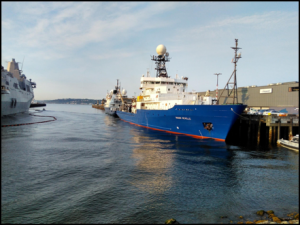
R/V Roger Revelle (front) and R/V Sally Ride (back) mobilizing for it’s next mission: EXPORTS
EXPORTS (EXport Processes in the Ocean for Remote Sensing) is a joint NASA/NSF funded project quantifying the export (or movement) of net primary production from the upper ocean to deep depths.
The original version of this post can be found on the NASA EXPORTS blog site here.
Summertime Science
“Hey Anna, want to help me make something?” Dr. Heather McNair asked me this simple question one day, and I was instantly intrigued. What were we going to make? What was it going to be used for? How were we going to put it all together? So many questions were running through my head, but I was ready to explore and learn.
This summer, I have been working in Dr. Susanne Menden-Deuer’s lab at the University of Rhode Island’s Graduate School of Oceanography as part of an NSF funded, REU program: SURFO (Summer Undergraduate Research Fellowship in Oceanography). My primary focus was to understand how environmental factors, such as turbulence, affect the way microscopic marine organisms graze on other organisms. While my primary research kept me busy, I wanted to explore other areas of oceanographic research, so I offered to help in the lab anywhere I could.
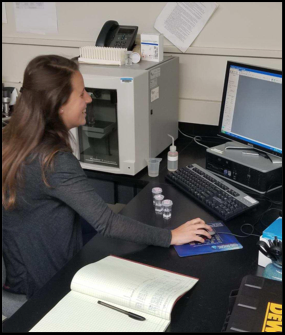
Dr. Heather McNair, a postdoctoral fellow in the Menden-Deuer Lab, explained that she was preparing for a research cruise as part of the EXPORTS project and wanted help making a positive pressure pump, a device used to automate water sampling. I had never even heard of a positive pressure pump before, and now I was supposed to make one?! Enthusiastic and eager to begin, I put my thinking skills to the test. She showed me some of the physical pieces and explained how we wanted our end product to function and look. Okay, sounded pretty self-explanatory, put a few pieces together and finished product done.
Except, one thing: we did not have all of the pieces, and needed to create this device using only items available in the lab. Similar to being out at sea, you cannot simply go to the store and get what you need, but have to figure out a way to make it work given the resources available. After a lot of trial and error, we created a device that would work well at sea. Mission accomplished.
Challenges facing science at sea
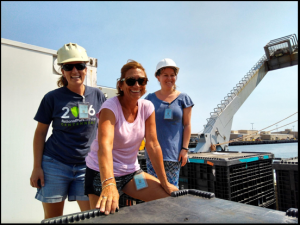
Dr. Ewelina Rubin (right) mobilizing the R/V Roger Revelle for EXPORTS
Unforeseen and challenging obstacles such as this one are common at sea. While it might seem simple, there are many fine details involved in preparing for a cruise. Think about an average science classroom, there are various instruments and glassware, as well as other fundamental components such as water sources, sinks, safety equipment, and more. You have to think about where all of these items will go on the ship, how to secure them for the natural movements of the ship at sea, etc. etc. Some things are simpler, such as determining how many bottles you need for an experiment, while others are more complex, like transporting a large, expensive instrument across the country that will undergo constant motion and likely rough, stormy seas. While this process is stressful for some, it is truly one of my favorite parts of a research cruise.
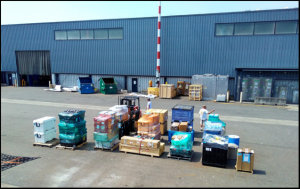
No matter how prepared scientists are, unexpected things always happen at sea- some of which include 12ft swells sloshing up against the side of the boat. That might not seem like much for an avid surfer, but for research vessels these waves can be felt instantaneously by members on board. I remember my last research cruise when we hit a wave a bit larger than I expected. I was performing an experiment and zoom, all of the bottles starting sliding across the table. Here I was trying to catch them, and hold my stance at the same time. In times like these, I truly appreciated that the tables were screwed into the walls, and the boxes under tables were held in place with ratchet straps.
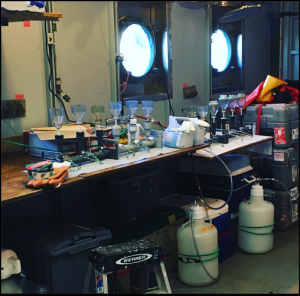
There are so many components to think about before going to sea, in addition to the simple things, like remembering to bring a toothbrush and an extra change of clothes. Staying organized is key. I cannot imagine trying to pack all of our equipment, without the handy packing list we had prepared. But more importantly, if I had one piece of advice for anyone preparing for a research cruise, be flexible, be prepared (well the best that you can be), and be excited. The thrill and excitement from performing research on a ship is extraordinary, something to truly embrace. Even if those long days and nights packing seem never ending, just remember it will be worth it and one of the most incredible, learning experiences of your life. To everyone on board the EXPORTS cruise, fair winds and following seas, the packing is done and now you have made it to the best part- researching at sea.
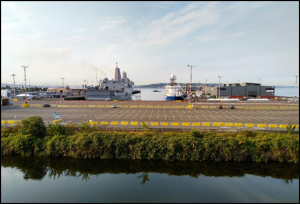
All images courtesy of the Menden-Deuer Lab
_________________________________________________________________
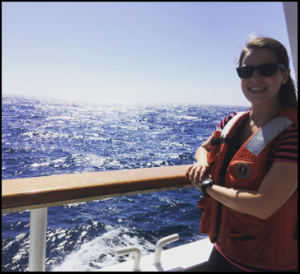
Anna Ward is a marine biology undergraduate at the University of California, San Diegowithin the Scripps Institution of Oceanography. This summer she is working with Dr. Susanne Menden-Deuer(advisor) and Dr. Gayantonia Franze(mentor) at the University of Rhode Island, Graduate School of Oceanography. She intends to pursue a career in oceanography, and has particular interest in microzooplankton motility and understanding how planktonic organisms respond to changes in surrounding environmental conditions. She is also passionate about furthering science communication through nontraditional media platforms and further promoting environmental conservation through education.
I am a third year PhD student at the University of Rhode Island Graduate School of Oceanography in the Lohmann Lab. My current research interests include environmental chemistry, water quality, as well as coastal and seabird ecology. When not in the lab, I enjoy diving, surfing, and hanging out with my dog Gypsy.

